Growing up in northern Minnesota, you learn how to fish. When I was young, my dad bought me a fishing rod and reel, set up a five-gallon bucket in the middle of our yard, and had me practice my casting. I would stand there for long stretches, reeling in my line, cranking my arm back, and releasing the line with a flick of my elbow.
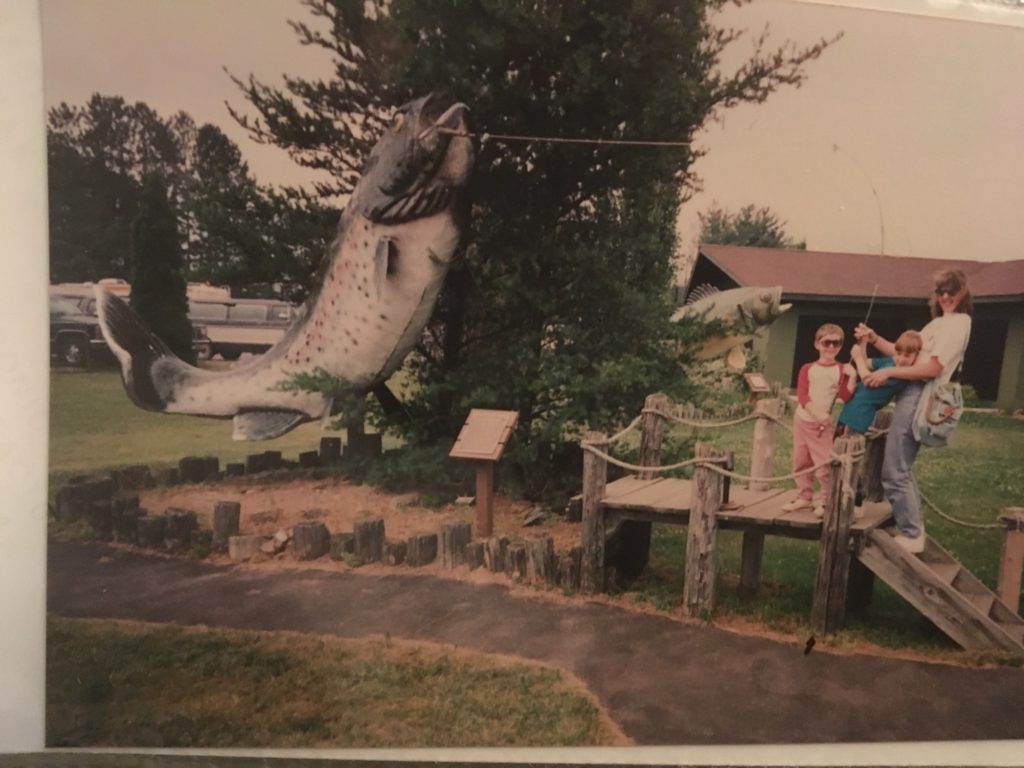
Most of the time, I wouldn’t hit the bucket. Sometimes I would nail it. In those moments, it felt like sinking a free throw in the final minutes of a tied basketball game. It was glorious.
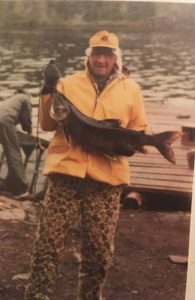
Unfortunately, my enthusiasm for sinking shots in the yard didn’t really translate to real life. I liked some elements of fishing—the quiet trolling, the plop the fishing lure makes when it hits the water, the satisfaction of reeling in a “keeper.” But I didn’t much have the patience for it. Or the luck. Most of the time, I barely got a bite, let alone a fish big enough to keep. The last time I caught a keeper, my brother threw it back, saying, “Oh. You wanted to keep that tiny thing?”
Yes. Yes, I did, Josh.
I haven’t fished in years, but my interest in it has once again awakened. When I started researching survivalist practices (for my work-in-progress novel), fishing would come up time and again. Fish are just…easy prey. It’s not their fault. Unlike a rabbit or a partridge, they can’t see their predator coming. They aren’t trained to think about threats above the water. As far as they’re concerned, not much exists beyond the brim of their liquid habitat. It’s the edge of the world. The moon and stars, pre-space travel.
Dangling a worm in the water and pulling out dinner is hugely appealing when you’re trying to survive. Thus, the popularity of fishing in survivalist blogs.
Now, I know how to bait a hook and throw a line. I know the general weather conditions and times of day that are best for catching fish. I have a sense of which habitats fish seek—where they hide during the day and where they like to mingle and breed. HOWEVER, I never really learned what to DO with the damn thing after its caught.
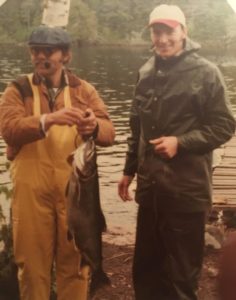
Okay, maybe I did learn, but I’ve forgotten everything I was taught (sorry, Dad!). So, this past month I’ve been doing a little research on how to best filet a fish. As it turns out, there are a few different schools of thought on the matter. There’s a traditional American style, a Japanese style, a Caribbean (and other areas, I’m sure) style of “Let’s cook the fish whole, eyeballs and all.” Notice I say a style, not the style. That’s because even people in the same region may clean and prep fish differently–there’s no one way to do it.
Essentially, no style is right or wrong and each style has its own set of challenges. This is the style I found to be easiest (it also happens to be similar to how my dad cleans fish–he just jogged my memory on that): https://www.youtube.com/watch?v=5GPYfqWgJfY
I decided to give it a try.
Here’s a video of me filleting a red snapper, purchased at Coastal Seafoods in Minneapolis. I chose Coastal Seafoods because A) I assumed they would have whole fish that I could fillet and B) They have high standards when it comes to seafood and sustainability–something I care very deeply about.
On a personal note, I stopped eating seafood in about 5th grade because I learned about all the bycatch that occurs when harvesting shrimp (other sea life getting caught up in the nets) and other seafood. I also learned how intelligent an octopus is. Srsly. Check it out. In later years, when I decided to try seafood again, I found I lost my taste for it. I still eat fish, but try to make sure it’s responsibly sourced. Okay. Back to your regularly scheduled program…
Essentially, you follow these steps:
Equipment:
- A VERY sharp fillet knife. My dad agrees with the common wisdom out there: the sharper the knife, the better.
- A flat surface on which to place the fish
- A place to dispose of the guts and bones (preferably far from camp, or the bears could come a knockin’)
- NOTE: Always cut away from yourself!
Cut One:
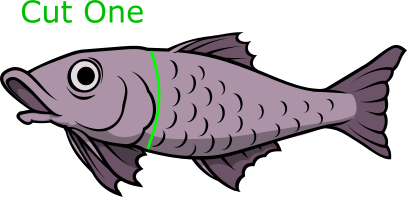 Place the fish on the flat surface with its head and tail perpendicular to you. Find the front fin and make a vertical cut behind it from the top of the fish down to its belly.
Place the fish on the flat surface with its head and tail perpendicular to you. Find the front fin and make a vertical cut behind it from the top of the fish down to its belly.
Cut Two:
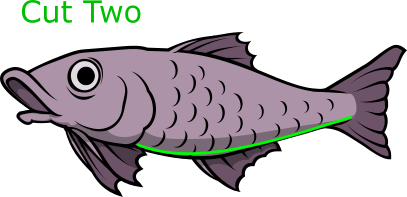 Cut along the body cavity (stomach) so you have an open flap
Cut along the body cavity (stomach) so you have an open flap
Cut Three:
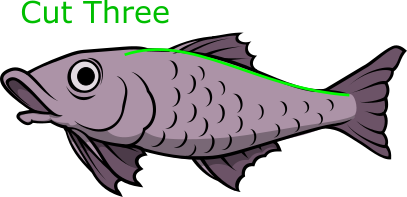 Go back to the head. Make sure the top of the fish is facing you. Place your knife* above the dorsal fin (aka fin rays), press down, and cut along the fin ray bones all the way down to the tail. From here, there are two divergent methods:
Go back to the head. Make sure the top of the fish is facing you. Place your knife* above the dorsal fin (aka fin rays), press down, and cut along the fin ray bones all the way down to the tail. From here, there are two divergent methods:
Cut Four (Method A):
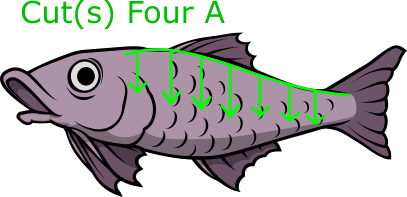 Keep cutting deeper from the top of the fish, down, using the fin ray bones as guides. Slowly cut deeper until you’re all the way through to the body cavity.
Keep cutting deeper from the top of the fish, down, using the fin ray bones as guides. Slowly cut deeper until you’re all the way through to the body cavity.
Method Four (Method B):
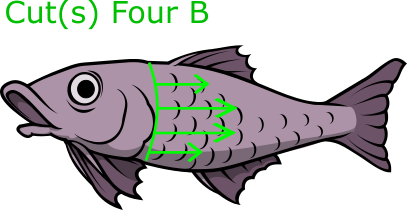 Start with the head and cut along to the tail, using the backbone as a guide.
Start with the head and cut along to the tail, using the backbone as a guide.
Cut Five:
Remove the fillet you’ve just sheared off the fish and place it skin-down on your flat surface. Start on one end and make a vertical cut until you feel the resistance of the skin. Turn your knife so that it is horizon and parallel to the fish’s skin. Cut along, keeping it flat. You may have to use a sawing motion at points.
THEN:
Feel for bones and remove them. Set the fillet aside, flip the fish, and cut out your second fillet. Dispose of the carcass.
Take your fillets, coat them in flour, dip ’em in whisked eggs, and coat them in panko bread crumbs and spices! Fry in hot oil. Eat. Pat yourself on the back.
That’s about it, folks! How about you? What’s your tried and true way of filleting a fish? HAVE you filleted a fish? If not, are you inspired to try it now? Or are you going to stick with your sushi (sustainably caught, I hope!)?
I hope you enjoyed this month’s survival focus. Stay tuned for next month’s…
*Pro Tip: Use your fillet knife’s flexibility to your advantage. Bend it almost like an “L” so that you can remove all the meat.
Author: KateBitters
Kate Bitters is a Minneapolis-based author and freelance writer. She is the author of Elmer Left, Ten Thousand Lines, and He Found Me. One of her proudest/nerdiest moments was when Neil Gaiman read one of her short stories on stage at the Fitzgerald Theater.
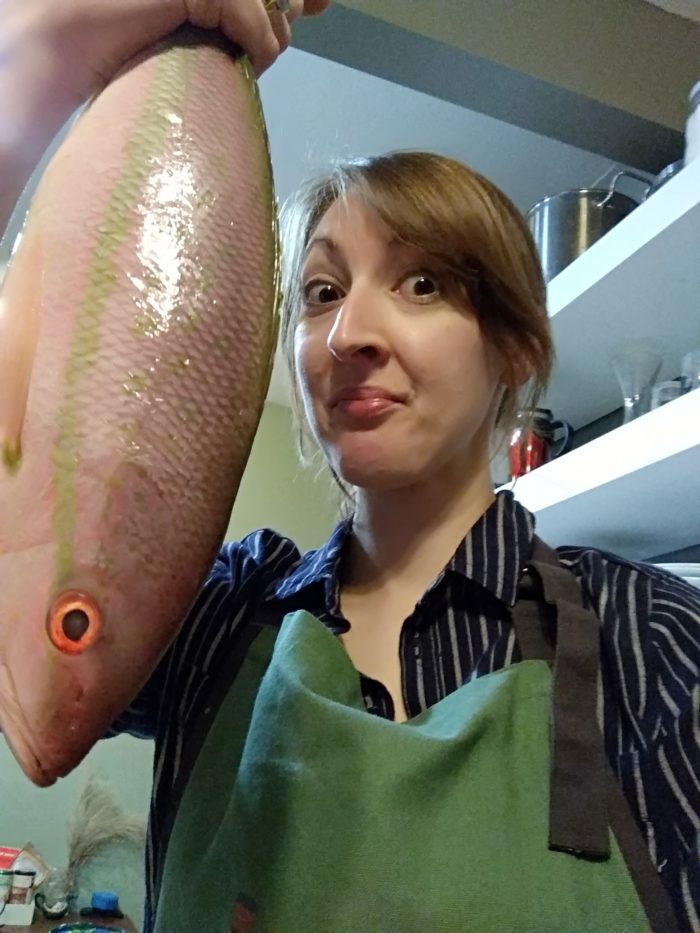
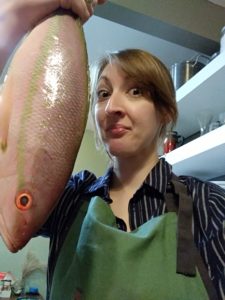
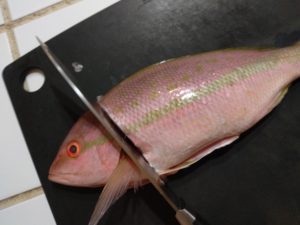
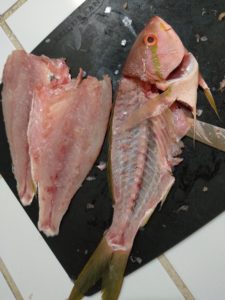


I’m envious. Seems like every time I come back to your website you have a new interesting thing for me to read. How do you stay so motivated? Do you research all of these posts before posting?
The motivation factor can be tough when I’m super busy (like now!). Yes, I’ve been researching before I write any of my survival-related posts. It’s fun, and I wish I had more time to devote to this project! Glad you’re liking the posts.